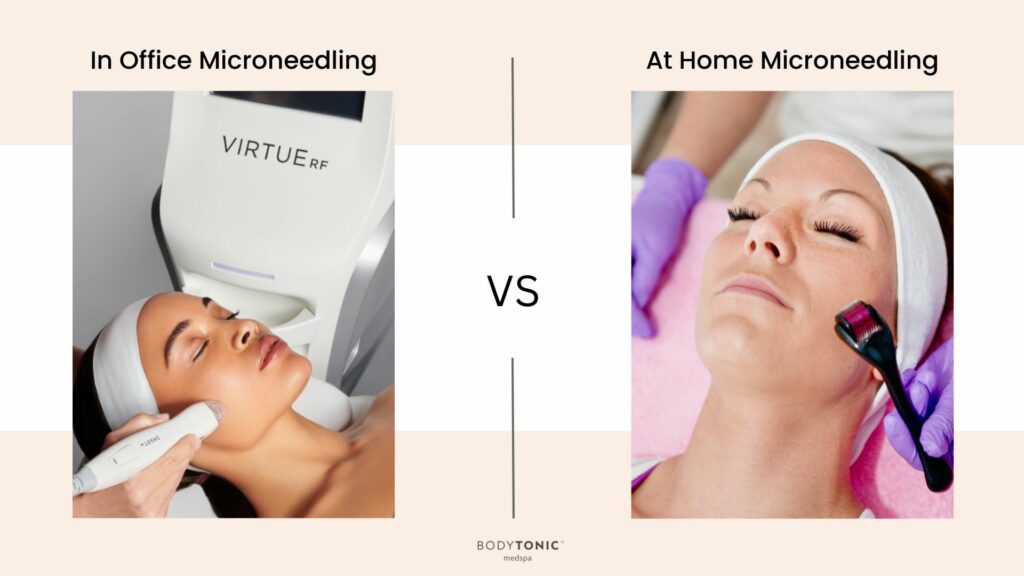Microneedling is an increasingly popular minimally invasive treatment for tackling a huge range of skin concerns – from skin laxity to wrinkles, and sunspots to scarring.
It involves puncturing your skin with hundreds of tiny needles – which might sound counterintuitive as a means of improving your skin… but the reality is that it’s one of the most effective skin rejuvenation treatments available, and not nearly as “scary” as it might first sound!
The amazing results and other benefits of microneedling have not only led to its status as one of the most popular medical spa treatments, but also to the development of increasingly advanced and customizable microneedling technologies, as well as a substantial DIY “at-home” microneedling market…
Which, unsurprisingly, has also led to lots of questions like, “What’s the difference between the different types of microneedling?”, “Does at-home microneedling actually work?”, “Which is best for me?”, and so many more….
So, let us explain.
What Are the Different Types of Microneedling?
The three main types of microneedling now available are:
- Traditional microneedling
- RF microneedling
- At-home microneedling
The main difference between them is that traditional and RF microneedling are both FDA-approved medical-grade aesthetic treatments that are performed by professionals in medical spas or other clinics, whereas at-home microneedling is a less effective version of the treatment people can perform on themselves, at home.
While the at-home options are based on the same principles, it will be no surprise to hear that both the technology and results are vastly different from the professional treatments.
RF and traditional microneedling, on the other hand, are far more similar to one another. RF microneedling is essentially a more advanced version of traditional microneedling, adding radiofrequency (RF) heat into the equation to achieve even better results.
Traditional microneedling – what it is and who it’s good for
Traditional microneedling, also known as Collagen Induction Therapy, is a treatment carried out by a licensed esthetician.
It involves a pen-like device that contains multiple sterile tiny (micro) needles being passed over the skin, puncturing it with the needles and creating hundreds of tiny microscopic wounds.
These wounds are small enough and controlled enough to not cause any damage in and of themselves. However, they are enough to prompt the body to kick its healing response into action, which includes the creation of new (and fresher-looking) skin, as well as a boost in collagen and elastin production – things that naturally diminish as we age, and which are largely responsible for the volume in our skin.
As a result, after treatment the skin looks plumper and smoother, fine lines and wrinkles are diminished, and age spots, acne scars, and other blemishes are all reduced thanks to the newer skin that is created in their place.
Traditional microneedling is best suited to people wanting to reverse some of the early signs of aging, maintain a more youthful appearance, and enjoy a smoother and more radiant complexion. It’s generally cheaper than laser treatments, and also comes with no risk of skin discoloration so is suitable for all skin colors.
Overall, microneedling is an excellent, safe, effective procedure, suitable to pretty much everyone.
The main benefits of traditional microneedling:
- Diminishes the appearance of fine lines and wrinkles
- Reduces the appearance of scars, including acne scars
- Minimizes the appearance of sunspots and other discoloration
- Smoothens and plumpens the skin
- Evens out the complexion
- Reduces the visibility of stretch marks
- Suitable for all skin types
- Works on the face and other parts of the body
- Fast, minimally invasive treatment with no downtime
- Safe, FDA-approved procedure
- Minimal pain thanks to the application of topical numbing creams
RF microneedling – what’s different vs traditional microneedling?
RF stands for radiofrequency, so RF microneedling is basically the same procedure as the traditional version, with the addition of radiofrequency energy – which is delivered via the needles themselves.
The RF energy converts to heat, which essentially “supercharges” all the healing effects – in particular, stimulating an even greater production of collagen which leads to a noticeably enhanced level of skin tightening.
Both the amount of energy and the needle depth can also be adjusted so as to better suit certain skin conditions, making it a highly customizable treatment.
Basically, RF microneedling is the gold-standard version of microneedling. It comes with all the same benefits as traditional microneedling, but with even better results.
The main benefits of RF microneedling vs traditional microneedling:
- All the same benefits as traditional microneedling, plus:
- Noticeably tighter skin
- Greater reduction of fine lines and wrinkles
- Greater reduction of skin discoloration and scars
- Overall more noticeable results
- Longer-lasting results
- Better results in fewer treatments
- Even faster recovery time
This means that RF microneedling is also suitable for most people, but it’s particularly beneficial for those with more noticable skin concerns or skin that is further along in the aging process.
At-home microneedling (a.k.a. dermarolling)
Most in-salon microneedling treatments now use a pen-like device. However, the treatment originated with the use of a “roller” style device, hence the name Dermarolling, and this is the most common type of at-home microneedling device – although pen-style devices do also now exist for the at-home market.
Dermarollers work in the same way in terms of the device containing lots of microneedles that cause micro wounds when rolled over the skin, which in turn prompts the “rejuvenating” healing response. However, the rollers have far less customizability as all needles are the same length, and they offer far less precision.
The needles on the at-home versions are also much shorter than those used in professional treatments, which is good from a safety perspective but does also mean they are far less effective. The at-home pens, on the other hand, do often come with longer needle sizes – but this comes with far more significant risks.
Most at-home microneedling devices will claim to reduce fine lines, scars, and hyperpigmentation if used regularly, but in reality, their impact is usually limited to a short-term brightening of the skin. Their only real advantage over professional microneedling is cost and convenience, but given the vastly reduced results, that benefit isn’t as good as it might first sound…
The main disadvantage of DIY microneedling is the risks. While professional microneedling is an incredibly safe procedure, when done at home it becomes far riskier – simply because of a lack of specialist knowledge, a lack of technique, and the fact you are breaking the surface of your skin, which in itself comes with a range of risks.
If you put too much pressure on the skin, the needles aren’t sterile, you penetrate the skin too deeply, or you do it on an active skin condition, you can risk serious skin infections or scarring.
It’s also not uncommon for the skin to take over a week to recover from DIY microneedling, compared to a matter of hours when done professionally.
The disadvantages of at-home microneedling
- Minimal and short-term results only
- No ability to adjust speed or depth of needles to adapt to different skin concerns or areas of skin
- Shorter needles don’t break past the top layer of skin, reducing healing response and so reducing the results
- Longer needles can result in significant and lasting damage if used incorrectly
- Much higher risk of infection
- Usually more painful, due to poor technique and weaker numbing creams
- No FDA-approved at-home microneedling devices exist
In-office vs at-home microneedling
Microneedling at home might be tempting in terms of its convenience, but given the potential risks and lesser results, we’d always recommend going professional…
In-office treatments are performed in a controlled environment, meaning they’re not only completely safe, but also carefully tailored to your specific needs. And because they’ll be carried out by a trained professional, using the most advanced technology, and with far more customization options, you’ll stand to enjoy the very best results possible.
Why we recommend professional microneedling over at-home microneedling
- More noticeable, longer-term results
- Trained professionals have the skill, technique, and understanding of how to treat your specific skin concerns
- Uses far more advanced microneedling devices that can adjust speed and depth to treat your individual needs
- Professional treatments are usually combined with booster serums, nutrients, and growth factors to achieve even better results
- No downtime due to better technology and technique
- Minimal pain due to stronger and better quality numbing creams than available over the counter
- Completely safe and FDA-approved when performed professionally
There are many great ways to care for your skin at home. But when it comes to more advanced treatments such as microneedling, we’d suggest leaving it to the professionals…
Microneedling at BodyTonic Cleveland
If you live or work in the Cleveland area and are interested in microneedling treatments, come and see us at BodyTonic med spa We offer both traditional microneedling and RF microneedling (using the groundbreaking Cartessa VirtueRF), meaning that we offer treatments to suit everyone, and can recommend the best treatment for your skin’s needs.
We always start with an in-depth and completely obligation-free consultation, so book yours today and find out the ways in which we can make your skin glow again!

